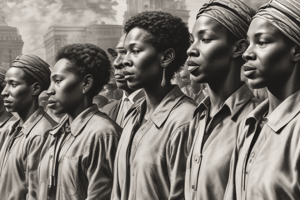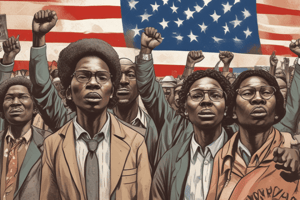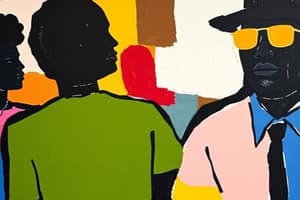Podcast
Questions and Answers
What was the focus of the Southern Christian Leadership Conference (SCLC)?
What was the focus of the Southern Christian Leadership Conference (SCLC)?
- Ensuring political and educational equality of minority group citizens
- Practicing peaceful, direct action protests
- Supporting southern blacks during the sit-in movement
- Ensuring political and educational equality in individual cities (correct)
Which organization practiced peaceful, direct action protests mainly comprised of Black college students?
Which organization practiced peaceful, direct action protests mainly comprised of Black college students?
- National Association for the Advancement of Colored People (NAACP)
- Congress of Racial Equality (CORE)
- Ku Klux Klan (KKK)
- Student Nonviolent Coordinating Committee (SNCC) (correct)
What was the main goal of the National Association for the Advancement of Colored People (NAACP)?
What was the main goal of the National Association for the Advancement of Colored People (NAACP)?
- Ensuring political and educational equality of minority group citizens (correct)
- Supporting southern blacks during the sit-in movement
- Practicing peaceful, direct action protests
- Hating black people
What characterizes the Ku Klux Klan (KKK)?
What characterizes the Ku Klux Klan (KKK)?
What marked the beginning of the Selma to Montgomery marches?
What marked the beginning of the Selma to Montgomery marches?
What is the main outcome of the Great Migration?
What is the main outcome of the Great Migration?
What event prompted the start of the Montgomery Bus Boycott?
What event prompted the start of the Montgomery Bus Boycott?
What is the main focus of the 24th Amendment?
What is the main focus of the 24th Amendment?
What was the aim of the Black Codes?
What was the aim of the Black Codes?
Who was a member of the right-wing Democratic splinter group known as Dixiecrats in the 1948 U.S. presidential election?
Who was a member of the right-wing Democratic splinter group known as Dixiecrats in the 1948 U.S. presidential election?
What did the Supreme Court declare in the Brown vs. Board case in 1954?
What did the Supreme Court declare in the Brown vs. Board case in 1954?
What was the main objective of the Civil Rights Act of 1964?
What was the main objective of the Civil Rights Act of 1964?
Who initiated sit-ins as a form of protest?
Who initiated sit-ins as a form of protest?
'Little Rock 9' refers to the first African American students who...
'Little Rock 9' refers to the first African American students who...
What did the 24th Amendment specifically prohibit?
What did the 24th Amendment specifically prohibit?
'Jim Crowe' laws were aimed at...
'Jim Crowe' laws were aimed at...
What was the focus of the Southern Christian Leadership Conference (SCLC)?
What was the focus of the Southern Christian Leadership Conference (SCLC)?
What specifically did the 24th Amendment prohibit?
What specifically did the 24th Amendment prohibit?
Who initiated sit-ins as a form of protest?
Who initiated sit-ins as a form of protest?
What marked the beginning of the Selma to Montgomery marches?
What marked the beginning of the Selma to Montgomery marches?
What characterizes the Ku Klux Klan (KKK)?
What characterizes the Ku Klux Klan (KKK)?
What was the primary aim of the Black Codes?
What was the primary aim of the Black Codes?
What did the 24th Amendment address?
What did the 24th Amendment address?
What characterized the Ku Klux Klan (KKK) in relation to civil rights?
What characterized the Ku Klux Klan (KKK) in relation to civil rights?
What was the main objective of the Civil Rights Act of 1964?
What was the main objective of the Civil Rights Act of 1964?
'Jim Crowe' laws were primarily aimed at...
'Jim Crowe' laws were primarily aimed at...
Flashcards are hidden until you start studying
Study Notes
Civil Rights Movement
- The Southern Christian Leadership Conference (SCLC) focused on nonviolent, Christian-based activism to achieve civil rights.
- The Student Nonviolent Coordinating Committee (SNCC) practiced peaceful, direct action protests, mainly comprised of Black college students.
Organizations and Their Goals
- The National Association for the Advancement of Colored People (NAACP) aimed to ensure the political, educational, social, and economic equality of minority group citizens.
- The Ku Klux Klan (KKK) was characterized by its white supremacist and terrorist ideology.
Key Events
- The Selma to Montgomery marches began with the brutal beating of peaceful protesters on Bloody Sunday, March 7, 1965.
- The Montgomery Bus Boycott was prompted by the arrest of Rosa Parks for refusing to give up her seat to a white person.
- The Great Migration marked the mass movement of African Americans from the rural South to urban cities in the North between 1910 and 1970.
Amendments and Legislation
- The 24th Amendment focused on prohibiting the federal government and states from requiring the payment of a poll tax as a condition of voting in federal elections.
- The Civil Rights Act of 1964 aimed to outlaw discrimination based on race, color, religion, sex, or national origin.
- The Black Codes were aimed at maintaining white supremacy and restricting the rights of freed slaves.
Protests and Figures
- Sit-ins as a form of protest were initiated by Ezell Blair Jr. (Jibreel Khazan), David Richmond, Franklin McCain, and Joseph McNeil.
- The 'Little Rock 9' refers to the first African American students who attended Little Rock Central High School in Arkansas, despite violent protests and opposition.
Laws and Restrictions
- 'Jim Crowe' laws were aimed at segregating and disenfranchising African Americans in the South.
- The Black Codes were primarily aimed at restricting the rights of freed slaves and maintaining white supremacy.
- The Supreme Court declared segregation in public schools unconstitutional in the Brown vs. Board of Education case in 1954.
- Strom Thurmond was a member of the right-wing Democratic splinter group known as Dixiecrats in the 1948 U.S. presidential election.
Studying That Suits You
Use AI to generate personalized quizzes and flashcards to suit your learning preferences.




